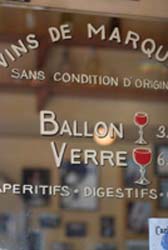 It’s three o’clock in the afternoon and after a hard day of traipsing the shopping streets of Lyon, France, you are feeling a little peckish. A cup of coffee, perhaps? With a nice pain au chocolat on the side? You look across the road at the choices for places that might be serving food: a restaurant, a cafè, a brasserie (which sounds extraordinarily like something you might buy at a lingerie shop). Which to choose? Which one would meet your needs and — this is important in France — not make you feel silly for having asked for the wrong thing in the wrong place?
It’s three o’clock in the afternoon and after a hard day of traipsing the shopping streets of Lyon, France, you are feeling a little peckish. A cup of coffee, perhaps? With a nice pain au chocolat on the side? You look across the road at the choices for places that might be serving food: a restaurant, a cafè, a brasserie (which sounds extraordinarily like something you might buy at a lingerie shop). Which to choose? Which one would meet your needs and — this is important in France — not make you feel silly for having asked for the wrong thing in the wrong place?
In this part of the world, all things to do with food are serious business, whether relishing a simple cup of espresso or enjoying a seven-course feast. Even the simple act of choosing where to go for hot chocolate can be fraught with the potential of cross-cultural embarrassment. Here, then, is a guide to the various types of eating establishments you might encounter in a French town or city:
Cafè
This is your best option if all you want is something to drink and perhaps a small bite to eat. Most cafès offer at least “petite restauration” such as croque monsieur (a grilled ham-and-cheese sandwich), salads, or assiette des frites (a plate of French fries). Some may even offer full meals. But if it says cafè on the front, you can be sure of your right to come in and occupy a table for an hour even if all you get is a tiny cup of coffee. (In Belgium, where I now live, to be able to rightfully do so is actually a law!) The French see a cafè as the perfect place to flâner, or hang out and watch the world go by. Another word for a cafè or pub is bistrot, which usually denotes a cafè that also serves meals.
Restaurant
This is the heavy hitter, gastronomically speaking. You should only go to an establishment marked “restaurant” when you are looking for an actual meal, preferably one with more than one course. In particular, don’t think of just ordering dessert — this is completely foreign to the French way of thinking, and you may be asked to order a meal or leave. Restaurants are usually open between noon and two for lunch, and some hour after seven or eight in the evening. (Forget the early bird specials!) Your best option is to choose one of their menus on offer, a predetermined list of courses, often with choices, for a single price, including service charge. These are likely to be a much better deal than choosing a la carte and will have been selected to harmonize with each other, like movements of a symphony.
Brasserie
This is the unusual one for more than the anagram you can make with its name. It literally means “brewery,” and may be either an actual brewery or an outlet for a particular brewer’s products; although, soft drinks and other alcoholic drinks are served in addition to beer. Usually, a brasserie will serve either drinks or meals, but does not serve snacks such as a plate of fries. In fact, I once managed to seriously offend a brasserie waiter by suggesting that I might want such a thing with my beer! (“Do you think, Madame, that we are a chip shop?”) However, keep in mind that a brasserie may be the best option if you are looking for a hearty one-course meal for your lunch or dinner.
Specialty eateries
Of course, there are various other places to eat, each with their own quirks. A patisserie or boulangerie is a pastry or bakery shop where the goods are baked on the premises. These usually open early in the morning and are a great place to eat breakfast. If you are in the mood just for dessert, you might want to try a crèperie, a gaufrerie, or a glacerie (crepes, waffles, and ice cream, respectively). A pizzeria is exactly what it sounds like, but be aware that you are expected to order a whole plate-size thin-crust pizza for each person rather than splitting them. In addition, there are many ethnic food places, often called snacks, which serve such things as pita sandwiches and French fries.
Choosing the right eating or drinking place in France is an act that brings you closer to the most culinary society in Western Europe. Of course, if things go wrong, you can always run to the ubiquitous restauration rapide — fast food!
